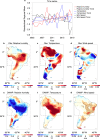Potential fire risks in South America under anthropogenic forcing hidden by the Atlantic Multidecadal Oscillation
- PMID: 35508473
- PMCID: PMC9068914
- DOI: 10.1038/s41467-022-30104-1
Potential fire risks in South America under anthropogenic forcing hidden by the Atlantic Multidecadal Oscillation
Abstract
Fires in South America have profound effects on climate change and air quality. Although anthropogenic forcing has exacerbated drought and fire risks, the fire emissions and aerosol pollution in the southern Amazon and the Pantanal region showed a consistent long-term decrease during the dry season (August-October) between 2003 and 2019. Here, we find that the decreasing trend in fire emissions, mainly located in the non-deforested region, was associated with climatic conditions unfavorable for intensifying and spreading fires, including increased humidity and slower surface wind speed. These climatic trends can be attributed to weakening of the positive phase of the Atlantic Multidecadal Oscillation, which has strengthened the northeast trade winds within the region (3°S-13°N) and the northwest winds east of the Andes that transport more moisture into the southern Amazon and the Pantanal region. Our findings show the mitigating effects of weakening of the positive Atlantic Multidecadal Oscillation phase on human-induced intensification of fire risks in South America and warn of potentially increased risks of fires and aerosol pollution under intensified anthropogenic forcing in the future.
© 2022. The Author(s).
Conflict of interest statement
The authors declare no competing interests.
Figures




References
-
- Masson-Delmotte, V. et al. IPCC: The Physical Science Basis. Contribution of Working Group I to the Sixth Assessment Report of the Intergovernmental Panel on Climate Change. (Cambridge Univ. Press, 2021).
-
- Stocker, T. F. et al. IPCC: The Physical Science Basis. Contribution of Working Group I to the Fifth Assessment Report of the Intergovernmental Panel on Climate Change. (Cambridge Univ. Press, 2013).
-
- Malhi Y, et al. The regional variation of aboveground live biomass in old-growth Amazonian forests. Glob. Change Biol. 2006;12:1107–1138. doi: 10.1111/j.1365-2486.2006.01120.x. - DOI
Publication types
MeSH terms
LinkOut - more resources
Full Text Sources

